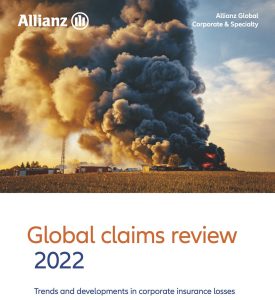
Insurance claims becoming more severe
By Adam Freill
Construction Risk ManagementAccording to corporate insurance carrier Allianz, fire, natural catastrophes and faulty workmanship are the top causes of insurance claims.
 Over the past five years, fire and explosion, natural catastrophes and faulty workmanship or maintenance have been the major causes of loss by value of insurance claims, according to Global Claims Review 2022 from Allianz Global Corporate & Specialty (AGCS).
Over the past five years, fire and explosion, natural catastrophes and faulty workmanship or maintenance have been the major causes of loss by value of insurance claims, according to Global Claims Review 2022 from Allianz Global Corporate & Specialty (AGCS).
“Insurance claims from companies have become more severe over the past five years due to factors such as higher property and asset values, more complex supply chains and the growing concentration of exposures in one location, such as in natural catastrophe-prone areas,” says AGCS chief claims officer and board member Thomas Sepp. “The future does not look brighter anytime soon. Companies and their insurers have shown resilience to weather the loss impact of the pandemic, but the ongoing war in Ukraine, a spike in the cost and frequency of business interruption losses, and the sustained elevated level of cyber claims are creating new challenges. At the same time, the top two causes of claims, fires and natural hazards, remain significant loss drivers for companies. Last but not least, the impact of soaring inflation around the world will bring further pressure on claims costs.”
Ultimately, inflation brings pressure on claims costs from multiple angles. Property and construction insurance claims, in particular, are exposed to higher inflation, as rebuilds and repairs are linked to the cost of materials and labour, while shortages and longer delivery times inflate business interruption (BI) values. Other lines of insurance, such as directors and officers, professional indemnity and general liability, are also susceptible to inflationary pressures through rising legal defense costs and higher settlements.
“Replacement costs more and replacement takes longer, and this means both the property damage and the business interruption loss are likely to be significantly higher,” says Sepp. “Updating insured values for all new contracts is therefore a pressing concern for insurers, brokers and insureds. If this doesn’t happen, our clients run the risk of not being fully reimbursed in the event of a loss, while insurers run the risk of underpricing exposures. The insurance market has already seen a number of claims where there has been a significant gap between the insured’s declared value and the actual replacement value.”
In its comprehensive analyses, AGCS has identified the top causes of loss for companies from more than 530,000 insurance claims in over 200 countries and territories that it has been involved with between 2017 and 2021.
The analysis shows that almost 75 per cent of financial losses stem from the top 10 causes of loss, while the top three causes account for close to half (45 per cent) of the value. Despite improvements in risk management and fire prevention, fire/explosion (excluding wildfires) is the largest single identified cause of corporate insurance losses, accounting for 21 per cent of the value of all claims.
Natural catastrophes (15 per cent) rank as the second-highest cause of loss globally by value of claims. Collectively, the top five causes are: hurricanes/tornados (29 per cent); storm (19 per cent); flood (14 per cent); frost/ice/snow (nine per cent) and earthquake/tsunami (six per cent), and account for 77 per cent of the value of all disaster claims.
Faulty workmanship/maintenance incidents are the third top cause of loss overall (accounting for nine per cent by value) and are also the second most frequent driver of claims, accounting for seven per cent by number, ranking only behind damaged goods with 11 per cent. Costly incidents can include collapse of building/structure/subsidence from faulty work, faulty manufacturing of products/components or incorrect design.
While not appearing in the top 10 causes of loss, the number of cyber claims has significantly increased over the past few years, driven by the rise of threats such as ransomware attacks, but also reflecting the growth of cyber insurance.
Taking a closer look at the Canadian figures, fire incidents account for close to 40 per cent of the value of losses, while natural catastrophes are the second major driver of losses at eight per cent. Faulty workmanship/maintenance losses rank third.
Water damage incidents, such as the flooding of buildings from burst pipes, are the most frequent driver of claims, accounting for around a quarter by number but total less than four per cent by value.
The full report can be found at https://www.agcs.allianz.com/news-and-insights/reports/claims-in-focus.html.




